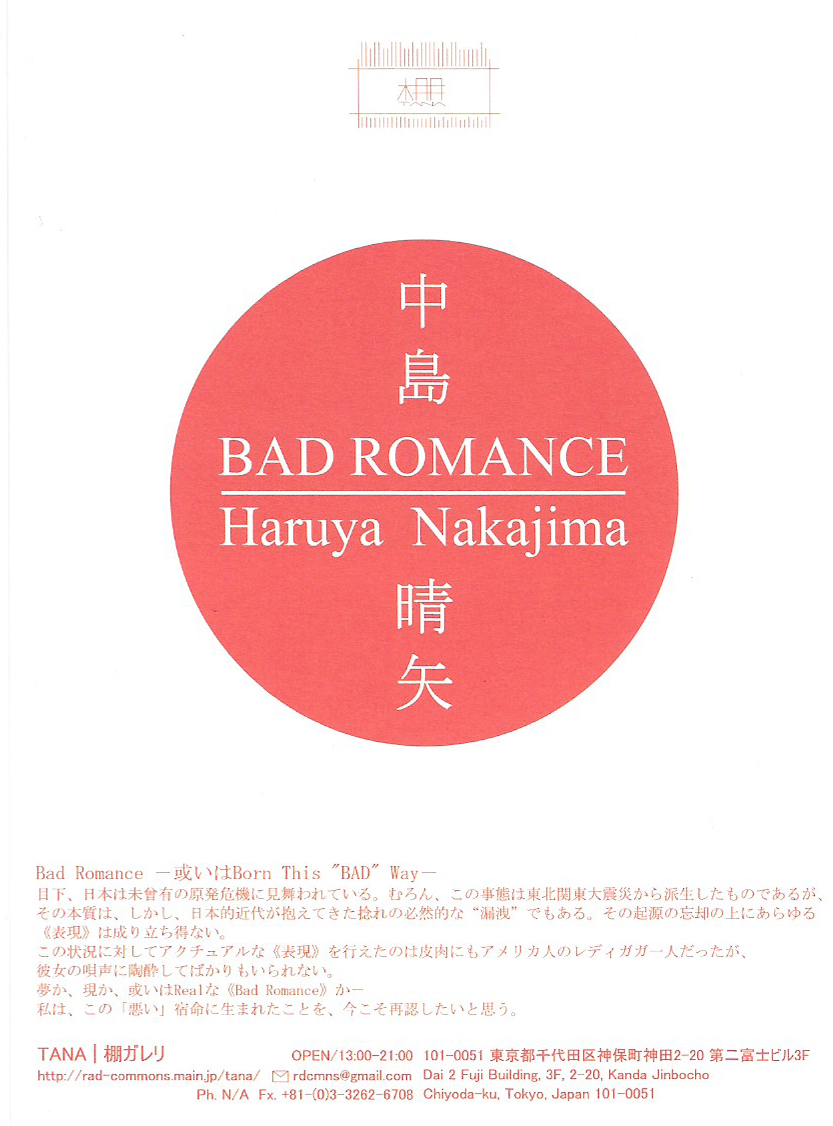名称:中島晴矢個展「BAD ROMANCE」
会場:TANA Gallery Bookshelf
会期:2011年8月6日〜8月15日
As a critical response to the ever-nationalizing “post-311” narratives proliferating since the nuclear crisis in Fukushima on 11 March 2011, TANA presents a postscript to the coming “post-311” era in advance, featuring an unnoticed but one of the most significant works responding the nuclear crisis, “Black Rain” by Haruya Nakajima.
On 11 March 2011, a massive quake to be remembered as the Great East Japan Earthquake shocked Japan, causing the nuclear crisis at Fukushima Daiichi Nuclear Power Plant followed by nation-wide anti-nuclear movements. The quake and consequential nuclear crisis was no doubt a significant moment that could have become a historical break, but now it seems well amended as the grand narrative by subtly manipulated nationalistic discourses, with museums and artists willingly undertaking the task of re-instilling the nationalism to the cracked nation, be it conscious or unconscious, in the name of morally unchallengeable goals such as “Kizuna [lit. tie]” as a nation or “recover” from the devastated land.
The video work “Black Rain” by Haruya Nakajima was originally shown in his solo exhibition “I WANNA BE STRONG” in late March, which was underway right before the quake and held in the midst of confusion left by the disaster. While many artists refrained themselves from showing their works as “imprudent” as so recommended by the prevalent discourses at that time, Haruya Nakajima produced “Black Rain” as his initial response to what happened in days following the disaster. Instead of immediately dealing with Fukushima, however, the video shows A-Bomb Dome in Hiroshima in a fixed angle as if shot by a spy camera, with a subtitle “Shot from 30km Away” on its upper right. This subtitle is taken from media coverage of the nuclear power plant by the defacto national TV network HNK during the most uncertain situations, and this very arbitrate “30km Away,” in the original context, had symbolically defined the safety zone by representing its inside unsafe to the national audience.
In contrast to many 311-related works that approached to Fukushima as a new national (and perhaps, global or at least globally appealing) symbol of Japan, “Black Rain” goes rather opposite – turning away from the spectacular representation of the sacred place, posing a question to its supposed authenticity, and revealing an unnoticed symbolic “zoning” as a subtle but bold political maneuver by the state apparatus to retrieve its temporarily undermined power to control people as a nation. Thus, leaving physically away from the accident site while approaching closely to its historical and symbolic core, Nakajima headed for Hiroshima, the origin and old symbol of Japanese nuclear experiences and following post-war Japan, where he filmed A-Bomb Dome in the same manner as the national coverage of the nuclear accident site and put “Shot from 30km Away” to suggest continuity from Hiroshima to Fukushima. Re-contextualizes the subtle symbolic zoning to the origin of post-war Japan, Nakajima portraits a history of a nation-state, or more properly of nation/state – the state as the privileged and the nation as the subordinated – as unchanged since its first encounter to the nuclear threat back in 1945.
“Black Rain” rejects spectacular or intuitively understandable representations for sympathetic audience, in attempt at capturing elusive manipulation of national sentiment as an exposure of the repeatedly executed state power. No longer a specific place with local realities, “Fukushima” as a brand-new national monument has orchestrated “post-311″grand narrative to lure innocent artists, museums and audience who in starry-eyes reinforce the stubborn core of the ever-accumulated state power in the beautiful name of social reconstruction. But “Black Rain” will keep reminding us of the aestheticized politics of “pos-311” art in Japan.
